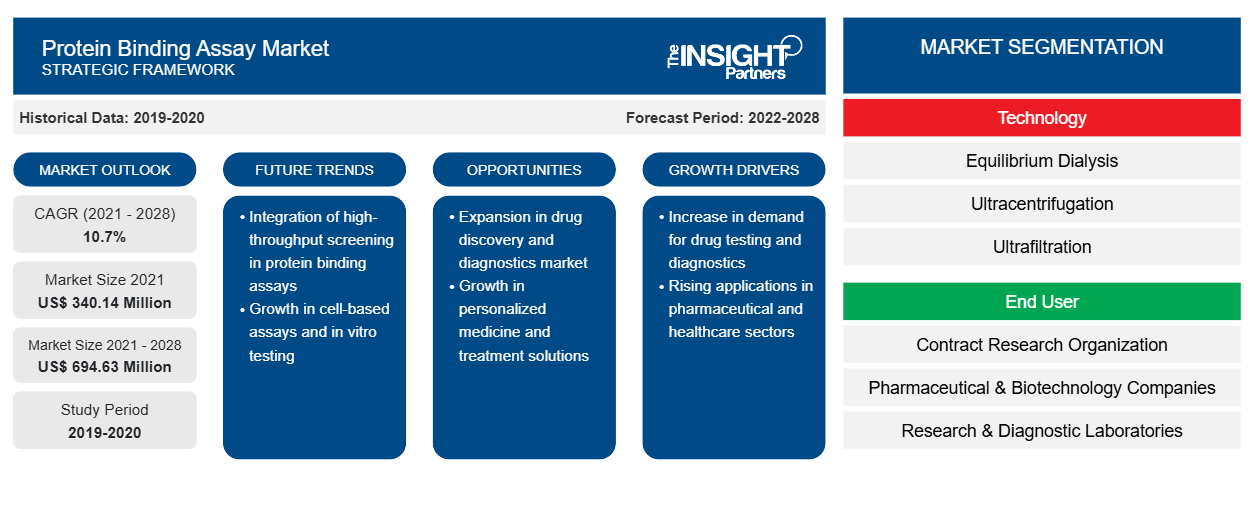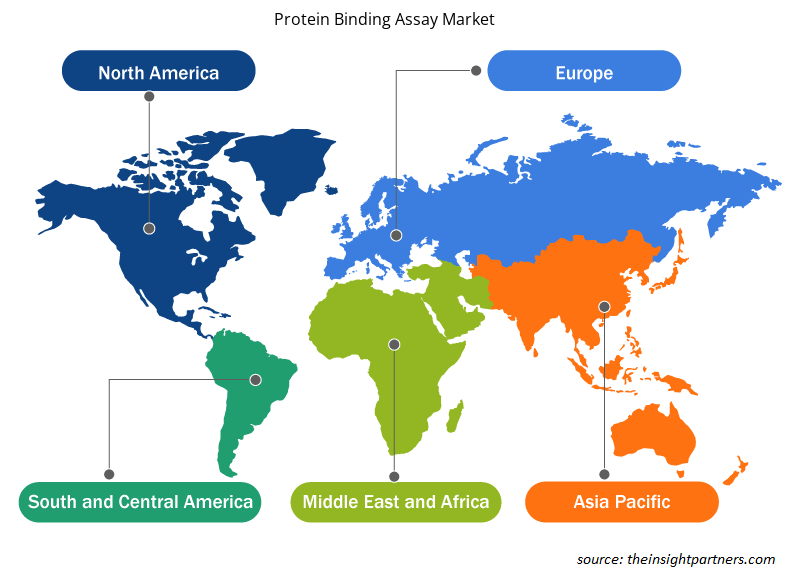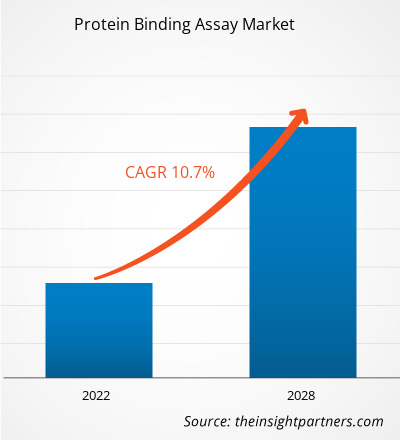The protein binding assay market is projected to reach US$ 694.63 million by 2028 from US$ 340.14 million in 2021; it is estimated to grow at a CAGR of 10.7% from 2021 to 2028.
Protein binding assays assist in analyzing the interaction between two types of proteins. These assays are widely used in the new drug development process.
The protein binding assay market is segmented on the bases of technology, end user, and geography. By geography, the market is broadly segmented into North America, Europe, Asia Pacific, the Middle East and Africa, and South and Central America. The report offers insights and in-depth analysis of the market, emphasizing on parameters such as market trends, technological advancements, and market dynamics, along with the analysis of competitive landscape of the globally leading market players.
Market Insights
Customize This Report To Suit Your Requirement
You will get customization on any report - free of charge - including parts of this report, or country-level analysis, Excel Data pack, as well as avail great offers and discounts for start-ups & universities
Protein Binding Assay Market: Strategic Insights

- Get Top Key Market Trends of this report.This FREE sample will include data analysis, ranging from market trends to estimates and forecasts.
You will get customization on any report - free of charge - including parts of this report, or country-level analysis, Excel Data pack, as well as avail great offers and discounts for start-ups & universities
Protein Binding Assay Market: Strategic Insights

- Get Top Key Market Trends of this report.This FREE sample will include data analysis, ranging from market trends to estimates and forecasts.
Growing Drug Discovery Activities Drive Protein Binding Assay Market Growth
A clinical trial is a crucial and significant step in the determination of the safety and effectiveness of a medical strategy, treatment, and device for commercial usage. These studies also help understand and determine the best medical approaches for a particular therapeutic area. Before the approval of drug molecules or medical devices by the regulatory authorities, a series of clinical studies are conducted. The increasing prevalence of communicable and non-communicable diseases is triggering the demand for the development of new drugs and medical devices, which, in turn, propels the demand for the protein binding assay. As per the data from the US National Library of Medicine, in 2018, there were ~280,801 clinical studies ongoing in 50 states and 204 countries. The following figure shows the rise in the number of studies registered in period of year 2015 to 2020.
Number of Registered Studies for Clinical Trials
Year First Posted | Studies at Start of Year | Studies During Year | Studies at End of Year |
2015 | 181,304 | 24,130 | 205,434 |
2016 | 205,434 | 27,809 | 233,243 |
2017 | 233,243 | 29,198 | 262,441 |
2018 | 262,441 | 17,836 | 280,277 |
2019 | 293,275 | 32,519 | 325,794 |
2020 | 325,794 | 36,740 | 362,534 |
Furthermore, pharmaceutical, medical device, and biotechnology companies focus on research and development (R&D) activities to develop new molecules for therapeutic applications with the greatest medical and commercial potential. The companies invest majorly in the R&Ds intending to deliver high quality and innovative products to the market.
Top 10 Pharmaceutical R&D Spenders, 2019
Name of Company (R&D Budget as % of Revenue) | Name of Company (R&D Budget as % of Revenue) |
1. F. Hoffmann La-Roche Ltd. (19.0%) | 2. Johnson & Johnson Services, Inc. (13.8%) |
3. Merck KGaA (21.1%) | 4. Novartis AG (19.8%) |
5. Pfizer, Inc. (16.7%) | 6. Sanofi S.A (16.7%) |
7. AbbVie, Inc. (19.0%) | 8. Bristol Myers Squibb Company Limited (23.6%) |
9. AstraZeneca Plc. (24.8%) | 10. GlaxoSmithKline Plc (13.8%) |
In the early stages of the drug development process, protein binding assays are being developed. Because unbound circulating drugs have the best access to targets and excretion pathways, drug candidate binding to plasma proteins is crucial for drug distribution, efficacy, and safety margin definition. According to Statista, around 7,493 drugs entered the preclinical stage in 2017, and the number is estimated to reach 8,040 in 2018. As a result, the total number of drug candidates being screened each year is increasing. Protein binding studies, which are conducted early in the drug development process, are an important aspect of the preclinical phase. Hence, the rising drug discovery activities coupled with increasing pharmaceutical R&D expenditure drives the growth of the protein binding assay market.
Rising Need of Reducing Drug Discovery and Development Costs Contributes Significantly to Protein Binding Assay Market Growth
The cost of developing new drugs remains high at an inflation-busting rate, and returns and profits on investments are declining, placing pressure on the entire innovative medicine system. Many pharmaceutical and biopharmaceutical research companies are re-evaluating old R&D policies and focusing their efforts on improving efficiency, increasing output, and satisfying unmet patient requirements due to current economic and political pressures to reduce the healthcare cost. The changing focus on drug discovery and development, and the rising use of new technologies for identifying and screening drug candidates are allowing research personnel to tap into various chronic, degenerative, and life-threatening disease segments that were previously untargeted.
Drug discovery and development is a costly process as it requires investments in funding, human resources, and technologies. Before launching a new drug in the market, strict adherence to regulations on testing and manufacturing standards is required. Furthermore, the failure of drug candidate during the development stage results in the wastage of entire investment. Protein binding studies assist in assessing binding and absorption capabilities in preclinical phases, resulting in lower drug attrition in the later stages of development, which helps optimize drug discovery expenses. Thus, rising need of reducing the cost of drug discovery and development process is fueling the protein binding assay market growth.
Technology Insights
Based on technology, the global protein binding assay market is segmented into ultracentrifugation ultrafiltration, equilibrium dialysis, surface plasmon, and others. In 2020, the equilibrium dialysis segment held the largest share of the market. However, the ultrafiltration segment is expected to register the highest CAGR in the market during 2021–2028. Equilibrium dialysis is among the most widely accepted methods for evaluating protein binding, and it can be performed with the help of rapid equilibrium dialysis (RED) devices. Researchers prefer this method as it has fewer binding effects to extraneous and unintended factors affecting research results.
End User Insights
Based on end user, the protein binding assay market is segmented into contract research organization, pharmaceutical and biotechnology companies, and research and diagnostic laboratories. The pharmaceutical and biotechnology companies segment is expected to hold the largest market share in 2021. It is also expected to be the largest shareholder in the market by 2028. These companies are the major adopters of CRO services; they approach CROs for outsourcing drug and molecule research and development. Protein binding is a fundamental biochemical process that is used to study the mechanism of drugs along with their pharmacological effects in subjects. These aspects are propelling the protein binding assay market for the market for the pharmaceutical and biotechnology companies segment.
Product launches, and mergers and acquisitions are highly adopted strategies by the players operating in the global protein binding assay market. A few of the recent key product developments are listed below:
In November 2020, Pharmaron Beijing Co., Limited acquired 100% assets of Absorption Systems, US, for up to US$ 137.5 million in cash. Absorption Systems is a leading scientific, non-clinical contract research organization (CRO) that provides small and large molecules, cell and gene therapies, and ocular and medical device products, among others, to pharmaceutical, biotechnology, and medical device companies; regulatory agencies; and research and testing organizations.
In April 2020, Sartorius acquired selected assets of Danaher Life Sciences successfully. The transaction was completed after obtaining the required regulatory approvals.
The pace of research and development of drugs and vaccines against the disease has increased during the COVID-19 pandemic. Protein binding is one of the key biochemical phenomena studied during the drug development process, as the cell receptors to which antigens on the infectious agents or drug molecules attach are mostly proteinic in nature. Thus, the pharmaceutical and biotechnological companies investing in product innovations frequently need protein binding assay materials and equipment.
Protein Binding Assay Market Regional Insights
The regional trends and factors influencing the Protein Binding Assay Market throughout the forecast period have been thoroughly explained by the analysts at The Insight Partners. This section also discusses Protein Binding Assay Market segments and geography across North America, Europe, Asia Pacific, Middle East and Africa, and South and Central America.

- Get the Regional Specific Data for Protein Binding Assay Market
Protein Binding Assay Market Report Scope
| Report Attribute | Details |
|---|---|
| Market size in 2021 | US$ 340.14 Million |
| Market Size by 2028 | US$ 694.63 Million |
| Global CAGR (2021 - 2028) | 10.7% |
| Historical Data | 2019-2020 |
| Forecast period | 2022-2028 |
| Segments Covered |
By Technology
|
| Regions and Countries Covered | North America
|
| Market leaders and key company profiles |
Protein Binding Assay Market Players Density: Understanding Its Impact on Business Dynamics
The Protein Binding Assay Market is growing rapidly, driven by increasing end-user demand due to factors such as evolving consumer preferences, technological advancements, and greater awareness of the product's benefits. As demand rises, businesses are expanding their offerings, innovating to meet consumer needs, and capitalizing on emerging trends, which further fuels market growth.
Market players density refers to the distribution of firms or companies operating within a particular market or industry. It indicates how many competitors (market players) are present in a given market space relative to its size or total market value.
Major Companies operating in the Protein Binding Assay Market are:
- Thermo Fisher Scientific, Inc.
- Merck KGaA
- Eurofins Scientific
- General Electric Company
- Sovicell GmbH
Disclaimer: The companies listed above are not ranked in any particular order.

- Get the Protein Binding Assay Market top key players overview
Protein Binding Assay – Market Segmentation
The global protein binding assay market is segmented on the bases of technology, end user, and geography. The market, by technology, is segmented into ultracentrifugation ultrafiltration, equilibrium dialysis, surface plasmon, and others. Based on end user, the protein binding assay market is segmented into contract research organizations, pharmaceutical and biotechnology companies, and research and diagnostic laboratories. The market, by geography, is broadly segmented into North America, Europe, Asia Pacific, the Middle East and Africa, and South and Central America.
Company Profiles
- Thermo Fisher Scientific, Inc.
- Merck KGaA
- Eurofins Scientific
- General Electric Company
- Sovicell GmbH
- Pharmaron Beijing Co., Ltd.
- Biotium, Inc.
- MicroConstants, Inc.
- Sartorius AG
Frequently Asked Questions
What are the future trends in the global protein binding assay market?
Label-free receptor assays to emerge as powerful assay platform in coming years are the future trends in the global protein binding assay market.
What are the report segments in the global protein binding assay market?
The global protein binding assay market is segmented on the bases of technology, end user, and geography. The market, by technology, is segmented into ultracentrifugation ultrafiltration, equilibrium dialysis, surface plasmon, and others. Based on end user, the protein binding assay market is segmented into contract research organizations, pharmaceutical and biotechnology companies, and research and diagnostic laboratories. The market, by geography, is broadly segmented into North America, Europe, Asia Pacific, the Middle East and Africa, and South and Central America.
What is the regional market scenario of protein binding assay?
Global protein binding assay market is segmented by region into North America, Europe, Asia Pacific, Middle East & Africa, and South & Central America. The North American region holds the largest market share of the market, whereas the Asia Pacific region is the fastest-growing region. The growth factors that are contributing to market’s growth in the North American region are growing elevation in research and development expenditures by the healthcare and life sciences companies in the region, especially in the US and Canada.
What are the driving factors for the protein binding assay market across the globe?
Key factors driving the growth of the market are growing drug discovery activities and pharmaceutical R&D expenditure and rising pressure to reduce drug discovery and development costs are boosting the market. However, challenges with existing technologies are likely to hinder the market’s growth.
Which are the key players in the protein binding assay market?
Key players in the market are Thermo Fisher Scientific, Inc., Merck KGaA, Eurofins Scientific, General Electric Company, Sovicell GmbH, Pharmaron Beijing Co., Ltd., Biotium, Inc., MicroConstants, Inc. and Sartorius AG among others.
What is protein binding assay?
Protein binding assay is method or a procedure that assist in analyzing the interaction between two types of proteins. The protein binding assays are widely used in the process of the new drug development. The thermophoresis techniques are expected to analyze the interaction between the proteins.
- Historical Analysis (2 Years), Base Year, Forecast (7 Years) with CAGR
- PEST and SWOT Analysis
- Market Size Value / Volume - Global, Regional, Country
- Industry and Competitive Landscape
- Excel Dataset
Testimonials
Reason to Buy
- Informed Decision-Making
- Understanding Market Dynamics
- Competitive Analysis
- Identifying Emerging Markets
- Customer Insights
- Market Forecasts
- Risk Mitigation
- Boosting Operational Efficiency
- Strategic Planning
- Investment Justification
- Tracking Industry Innovations
- Aligning with Regulatory Trends
Yes! We provide a free sample of the report, which includes Report Scope (Table of Contents), report structure, and selected insights to help you assess the value of the full report. Please click on the "Download Sample" button or contact us to receive your copy.
Absolutely — analyst assistance is part of the package. You can connect with our analyst post-purchase to clarify report insights, methodology or discuss how the findings apply to your business needs.
Once your order is successfully placed, you will receive a confirmation email along with your invoice.
• For published reports: You’ll receive access to the report within 4–6 working hours via a secured email sent to your email.
• For upcoming reports: Your order will be recorded as a pre-booking. Our team will share the estimated release date and keep you informed of any updates. As soon as the report is published, it will be delivered to your registered email.
We offer customization options to align the report with your specific objectives. Whether you need deeper insights into a particular region, industry segment, competitor analysis, or data cut, our research team can tailor the report accordingly. Please share your requirements with us, and we’ll be happy to provide a customized proposal or scope.
The report is available in either PDF format or as an Excel dataset, depending on the license you choose.
The PDF version provides the full analysis and visuals in a ready-to-read format. The Excel dataset includes all underlying data tables for easy manipulation and further analysis.
Please review the license options at checkout or contact us to confirm which formats are included with your purchase.
Our payment process is fully secure and PCI-DSS compliant.
We use trusted and encrypted payment gateways to ensure that all transactions are protected with industry-standard SSL encryption. Your payment details are never stored on our servers and are handled securely by certified third-party processors.
You can make your purchase with confidence, knowing your personal and financial information is safe with us.
Yes, we do offer special pricing for bulk purchases.
If you're interested in purchasing multiple reports, we’re happy to provide a customized bundle offer or volume-based discount tailored to your needs. Please contact our sales team with the list of reports you’re considering, and we’ll share a personalized quote.
Yes, absolutely.
Our team is available to help you make an informed decision. Whether you have questions about the report’s scope, methodology, customization options, or which license suits you best, we’re here to assist. Please reach out to us at sales@theinsightpartners.com, and one of our representatives will get in touch promptly.
Yes, a billing invoice will be automatically generated and sent to your registered email upon successful completion of your purchase.
If you need the invoice in a specific format or require additional details (such as company name, GST, or VAT information), feel free to contact us, and we’ll be happy to assist.
Yes, certainly.
If you encounter any difficulties accessing or receiving your report, our support team is ready to assist you. Simply reach out to us via email or live chat with your order information, and we’ll ensure the issue is resolved quickly so you can access your report without interruption.















The List of Companies - Protein Binding Assay Market
- Thermo Fisher Scientific, Inc.
- Merck KGaA
- Eurofins Scientific
- General Electric Company
- Sovicell GmbH
- Pharmaron Beijing Co., Ltd.
- Biotium, Inc.
- MicroConstants, Inc.
- Sartorius AG






 Get Free Sample For
Get Free Sample For